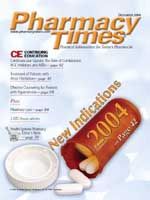Publication
Article
Pharmacy Times
Let's Get to the Point!
Problem
Numbers containing decimal points are a major source of error and, when the decimal point is misplaced, can lead to misinterpretation of prescriptions. Decimal points can be easily overlooked, especially on prescriptions that have been faxed, prepared on lined order sheets or prescription pads, or written or typed on carbon and no-carbon-required (NCR) forms. If a decimal point is missed, an overdose may occur. The importance of proper decimal point placement and prominence cannot be overstated.
A decimal point always should be preceded by a whole number and never should be left "naked." Decimal expressions of numbers less than 1 always should be preceded by a zero (0) to enhance the visibility of the decimal.
As an example, without a leading zero, a prescription for "Haldol .5 mg" (Figure) was misinterpreted and dispensed as "Haldol 5 mg." The patient received several 5 mg doses because the decimal point was overlooked.
In addition, a whole number never should be followed by a decimal point and a zero. These "trailing zeros" (eg, "3.0") are a frequent cause of 10-fold overdoses and never should be used. For example, when prescriptions have been written for "Coumadin 1.0 mg," patients have received 10 mg in error.
Dangerous use of decimals also can be problematic if they appear in electronic order-entry systems or on computergenerated labels. A newly admitted hospital patient told her physician that she took phenobarbital 400 mg 3 times daily. Subsequently, the physician wrote an order for the drug in the dose relayed by the patient. A nurse saw the patient's prescription vial and verified that it was the correct dose. Prior to dispensing, however, a hospital pharmacist investigated the unusually high dose. When he checked the prescription vial, he found that it was labeled as "phenobarbital 32.400MG tablet." Because of the way it appeared on the label, both the patient and the nurse had seen only "400MG." The hospital pharmacist contacted the outpatient pharmacy and suggested that the computer expression be changed to avoid serious medication errors. The pharmacy management agreed and made the change immediately.
Safe Practice Recommendations
In order to avoid misinterpretations due to decimal point placement, the Institute for Safe Medication Practices recommends that health care practitioners consider the following:
- Always include a leading zero for dosage strengths or concentrations less than 1
- Never follow a whole number with a decimal point and a zero (trailing zero)
- Educate the staff about the dangers involved with expressing doses using naked decimal points and trailing zeros
- Eliminate dangerous decimal dose expressions from pharmacy and prescriber electronic order-entry screens, computer-generated labels, preprinted prescriptions, and the like
- Avoid using decimals whenever a satisfactory alternative exists. For example, use 500 mg in place of 0.5 gram, 125 mcg instead of 0.125 mg, or 21/2 mg instead of 2.5 mg.
- Identify drugs with known 10-fold differences in dosage strength (eg, Cytomel 5 mcg and 50 mcg, Coumadin 1 mg and 10 mg, levothyroxine 25 mcg and 250 mcg), and place reminders in electronic order-entry systems and on pharmacy shelves to alert practitioners to double check the dosage strength
- When sending and receiving prescriptions via fax, keep in mind that decimal points can be easily missed due to "fax noise." Whenever possible, prescribers should give the original prescription to the patient to take to the pharmacy for verification. Pharmacists should carefully review faxed prescriptions and clarify prescriptions that contain fax noise.
- Eliminate the lines on the back copy of NCR forms so that a person can clearly see decimal points or other marks that were made on the top copy.
Drs. Kelly and Vaida are both with the Institute for Safe Medication Practices (ISMP). Dr. Kelly is the editor of ISMP Medication Safety Alert! Community/ Ambulatory Care Edition, and Dr. Vaida is the executive director of ISMP.
Report Medication Errors
The reports described here were received through the USP Medication Errors Reporting Program, which is presented in cooperation with the Institute for Safe Medication Practices (ISMP). ISMP is a nonprofit organization whose mission is to understand the causes of medication errors and to provide time-critical error-reduction strategies to the health care community, policy makers, and the public. Throughout this series, the underlying system causes of medication errors will be presented to help readers identify system changes that can strengthen the safety of their operation. If you have encountered medication errors and would like to report them, you may call ISMP at 800-324-5723(800-FAILSAFE) or USP at 800-233-7767 (800-23-ERROR). ISMP's Web address is www.ismp.org.
Subscribe to Newsletter
Pharmacy Times and the Institute for Safe Medication Practices (ISMP) would like to make community pharmacy practitioners aware of a publication that is available. The ISMP Medication Safety Alert! Community/Ambulatory Care Edition is a monthly compilation of medication-related incidents, error-prevention recommendations, news, and editorial content designed to inform and alert community pharmacy practitioners to potentially hazardous situations that may affect patient safety. Individual subscription prices are $45 per year for 12 monthly issues. Discounts are available for organizations with multiple pharmacy sites. This newsletter is delivered electronically. For more information, contact ISMP at 215-947- 7797, or send an e-mail message to [email protected].

Newsletter
Stay informed on drug updates, treatment guidelines, and pharmacy practice trends—subscribe to Pharmacy Times for weekly clinical insights.






